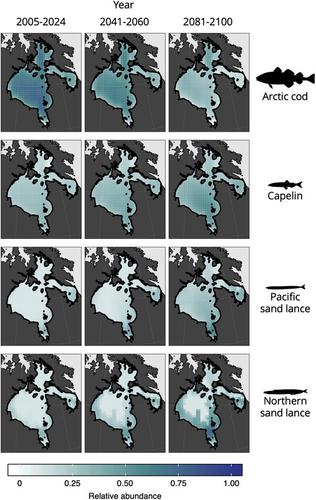当前位置:
X-MOL 学术
›
Ecol. Lett.
›
论文详情
Our official English website, www.x-mol.net, welcomes your
feedback! (Note: you will need to create a separate account there.)
Predicting how climate change threatens the prey base of Arctic marine predators
Ecology Letters ( IF 7.6 ) Pub Date : 2021-09-01 , DOI: 10.1111/ele.13866 Katie R N Florko 1 , Travis C Tai 1 , William W L Cheung 1 , Steven H Ferguson 2, 3 , U Rashid Sumaila 1 , David J Yurkowski 2, 3 , Marie Auger-Méthé 1, 4
Ecology Letters ( IF 7.6 ) Pub Date : 2021-09-01 , DOI: 10.1111/ele.13866 Katie R N Florko 1 , Travis C Tai 1 , William W L Cheung 1 , Steven H Ferguson 2, 3 , U Rashid Sumaila 1 , David J Yurkowski 2, 3 , Marie Auger-Méthé 1, 4
Affiliation

|
Arctic sea ice loss has direct consequences for predators. Climate-driven distribution shifts of native and invasive prey species may exacerbate these consequences. We assessed potential changes by modelling the prey base of a widely distributed Arctic predator (ringed seal; Pusa hispida) in a sentinel area for change (Hudson Bay) under high- and low-greenhouse gas emission scenarios from 1950 to 2100. All changes were relatively negligible under the low-emission scenario, but under the high-emission scenario, we projected a 50% decline in the abundance of the well-distributed, ice-adapted and energy-rich Arctic cod (Boreogadus saida) and an increase in the abundance of smaller temperate-associated fish in southern and coastal areas. Furthermore, our model predicted that all fish species declined in mean body size, but a 29% increase in total prey biomass. Declines in energy-rich prey and restrictions in their spatial range are likely to have cascading effects on Arctic predators.
中文翻译:

预测气候变化如何威胁北极海洋捕食者的猎物基地
北极海冰损失对捕食者有直接影响。气候驱动的本地和入侵猎物物种分布变化可能会加剧这些后果。我们通过对1950 年至 2100 年间高温室气体排放情景和低温室气体排放情景下的哨兵区(哈德逊湾)中广泛分布的北极捕食者(环斑海豹;Pusa hispida)的猎物基地进行建模来评估潜在变化。所有变化均为在低排放情景下相对可以忽略不计,但在高排放情景下,我们预计分布良好、适应冰层和能源丰富的北极鳕鱼的丰度将下降 50%(Boreogadus saida) 以及南部和沿海地区小型温带相关鱼类的丰度增加。此外,我们的模型预测所有鱼类的平均体型均有所下降,但总猎物生物量却增加了 29%。富含能量的猎物的减少和它们空间范围的限制可能会对北极捕食者产生连锁效应。
更新日期:2021-09-01
中文翻译:

预测气候变化如何威胁北极海洋捕食者的猎物基地
北极海冰损失对捕食者有直接影响。气候驱动的本地和入侵猎物物种分布变化可能会加剧这些后果。我们通过对1950 年至 2100 年间高温室气体排放情景和低温室气体排放情景下的哨兵区(哈德逊湾)中广泛分布的北极捕食者(环斑海豹;Pusa hispida)的猎物基地进行建模来评估潜在变化。所有变化均为在低排放情景下相对可以忽略不计,但在高排放情景下,我们预计分布良好、适应冰层和能源丰富的北极鳕鱼的丰度将下降 50%(Boreogadus saida) 以及南部和沿海地区小型温带相关鱼类的丰度增加。此外,我们的模型预测所有鱼类的平均体型均有所下降,但总猎物生物量却增加了 29%。富含能量的猎物的减少和它们空间范围的限制可能会对北极捕食者产生连锁效应。











































 京公网安备 11010802027423号
京公网安备 11010802027423号